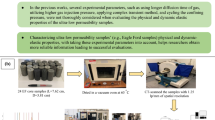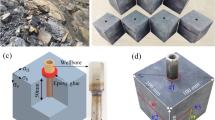Abstract
Liquid nitrogen (LN2) can dramatically deteriorate the rock and create more fractures in high-temperature reservoirs, such as deep hydrocarbon reservoirs. The present study systematically investigates the mechanical strength change and fracture morphology evolution in a deep shale gas reservoir subject to LN2 freezing. The mineral components of three shales were measured by X-ray diffractometry (XRD). The uniaxial compressive and tensile experiments studied the mechanical strengths of shales under different LN2 freezing parameters. Scanning electron microscope (SEM) and nuclear magnetic resonance (NMR) analyse microstructural changes. The results indicated that LN2 freezing could effectively increase pore volume and induce bedding planes and longitudinal fractures in the deep shale at a high temperature. The freezing cycle will generate complex fracture networks at micro and macro levels. Intergranular cracks easily occur between quartz particle boundaries. The shale with fewer clay minerals is a rational target for LN2 fracturing. Two regression models were developed to predict the uniaxial compressive and tensile strengths of deep shale after LN2 freezing. The crucial findings are expected to provide fundamental guidance for developing deep shale resources in a feasible and environmentally acceptable way.
Highlights
-
LN2 freezing can expand pore space and induce complex fractures in deep shale reservoirs.
-
LN2 freezing has more damage effect on the deep shale with more clay minerals
-
The brittle shale is a rational target for LN2 fracturing.
-
Two models are developed to predict the uniaxial compressive and tensile strengths of deep shale by LN2 freezing.



















Similar content being viewed by others
References
ASTM D (2008) Standard test method for splitting tensile strength of intact rock core specimens. ASTM International, Conshohocken
ASTM CCM-a (2014) Standard practice for making and curing concrete test specimens in the laboratory. ASTM International, Conshohocken
Bandara KMAS, Ranjith PG, Kumari WGP (2022) A coupled X-ray imaging and experimental permeability study of propped hydraulically induced fractures. Rock Mech Rock Eng 55(5):2581–2596
Cai C et al (2021) Experimental investigation on the breakdown behaviours of sandstone due to liquid nitrogen fracturing. J Petrol Sci Eng 200:108386
Cha M et al (2014) Cryogenic fracturing for reservoir stimulation—laboratory studies. J Petrol Sci Eng 124:436–450
Cha M et al (2018) Cryogenic fracturing of wellbores under true triaxial-confining stresses: experimental investigation. SPE J 23(04):1271–1289
Chang X (2019) Laboratory analysis of liquid injection method on hydraulic fracturing initiation and propagation in deep shale formation. Nat Gas Ind B 6(6):652–658
Elwegaa K, Emadi H (2018) The effect of thermal shocking with nitrogen gas on the porosities, permeabilities, and rock mechanical properties of unconventional reservoirs. Energies 11:2131
Elwegaa K, Emadi H (2019) Improving oil recovery from shale oil reservoirs using cyclic cold nitrogen injection—an experimental study. Fuel 254:115716
Grundmann SR, Rodvelt GD, Dials GA, Allen RE (1998) Cryogenic nitrogen as a hydraulic fracturing fluid in the Devonian Shale. In: SPE Eastern regional meeting
Guo R et al (2020) The role of the spatial heterogeneity and correlation length of surface wettability on two-phase flow in a CO2-water-rock system. Adv Water Resour 146:103763
Han S, Cheng Y, Gao Q, Yan C, Han Z (2018) Experimental study of the effect of liquid nitrogen pretreatment on shale fracability. J Nat Gas Sci Eng 60:11–23
Han S et al (2020) Experimental study on brittle response of shale to cryogenic fluid nitrogen treatment. J Petrol Sci Eng 194:107463
Hassanvand M, Moradi S, Fattahi M, Zargar G, Kamari M (2018) Estimation of rock uniaxial compressive strength for an Iranian carbonate oil reservoir: modeling vs. artificial neural network application. Petrol Res 3(4):336–345
He J, Zhang Y, Li X, Wan X (2019) Experimental investigation on the fractures induced by hydraulic fracturing using freshwater and supercritical CO2 in shale under uniaxial stress. Rock Mech Rock Eng 52(10):3585–3596
Hou B, Chang Z, Fu W, Muhadasi Y, Chen M (2019) Fracture initiation and propagation in a deep shale gas reservoir subject to an alternating-fluid-injection hydraulic-fracturing treatment. SPE J 24(04):1839–1855
Igarashi G, Maruyama I, Nishioka Y, Yoshida H (2015) Influence of mineral composition of siliceous rock on its volume change. Constr Build Mater 94:701–709
Lin H et al (2020) Damage caused by freeze-thaw treatment with liquid nitrogen on pore and fracture structures in a water-bearing coal mass. Energy Sci Eng 8(5):1667–1680
Lin H et al (2022) Dynamic displacement of adsorbed methane by fracturing fluid during soaking in a shale gas reservoir based on low-field nuclear magnetic resonance. J Petrol Sci Eng 208:109582
Ma X et al (2020) Insights into NMR response characteristics of shales and its application in shale gas reservoir evaluation. J Nat Gas Sci Eng 84:103674
McDaniel BW, Grundmann SR, Kendrick WD, Wilson DR, Jordan SW (1997) Field Applications of cryogenic nitrogen as a hydraulic fracturing fluid. In: SPE annual technical conference and exhibition
McElroy PD et al (2021) Artificial neural network (ANN) approach to predict unconfined compressive strength (UCS) of oil and gas well cement reinforced with nanoparticles. J Nat Gas Sci Eng 88:103816
Miskimins J (2020) Hydraulic fracturing: fundamentals and advancements. Society of Petroleum Engineers
Qin L et al (2017) Changes in the petrophysical properties of coal subjected to liquid nitrogen freeze-thaw—a nuclear magnetic resonance investigation. Fuel 194:102–114
Qu H et al (2020) Effect of shale mineralogy characteristics on the perforation performance and particle fragmentation of abrasive waterjet. Powder Technol 367:427–442
Qu H et al (2022a) Characteristics of complex fractures by liquid nitrogen fracturing in brittle shales. Rock Mech Rock Eng 55(4):1807–1822
Qu H et al (2022b) The investigation of proppant particle-fluid flow in the vertical fracture with a contracted aperture. SPE J 27(01):274–291
Shao Z, Tang X, Wang X (2021a) The influence of liquid nitrogen cooling on fracture toughness of granite rocks at elevated temperatures: An experimental study. Eng Fract Mech 246:107628
Shao Z, Tang X, Wang X (2021b) The influence of liquid nitrogen cooling on fracture toughness of granite rocks at elevated temperatures: an experimental study. Eng Fract Mech 246:107628
Siddhamshetty P, Narasingam A, Liu S, Valkó PP, Kwon JS-I (2018) Feedback control of proppant bank heights during hydraulic fracturing for enhanced productivity in shale formations. In: Eden MR, Ierapetritou MG, Towler GP (eds) Computer aided chemical engineering. Elsevier, pp 703–708
Speight JG (2017) Chapter one—gas and oil in tight formations. In: Speight JG (ed) Deep shale oil and gas. Gulf Professional Publishing, Boston, pp 1–61
Suboyin A, Rahman MM, Haroun M (2020) Hydraulic fracturing design considerations, water management challenges and insights for Middle Eastern shale gas reservoirs. Energy Rep 6:745–760
Sun Y, Zhai C, Xu J, Cong Y, Zheng Y (2021) Experimental study on pore structure evolution of coal in macroscopic, mesoscopic, and microscopic scales during liquid nitrogen cyclic cold-shock fracturing. Fuel 291:120150
Testamanti MN, Rezaee R (2017) Determination of NMR T2 cut-off for clay bound water in shales: a case study of Carynginia Formation, Perth Basin, Western Australia. J Petrol Sci Eng 149:497–503
Wang L et al (2021) Rock mechanical characteristics of deep marine shale in southern China, a case study in Dingshan block. J Petrol Sci Eng 204:108699
Wu X et al (2018) Investigation on the damage of high-temperature shale subjected to liquid nitrogen cooling. J Nat Gas Sci Eng 57:284–294
Wu X et al (2019a) Variations of physical and mechanical properties of heated granite after rapid cooling with liquid nitrogen. Rock Mech Rock Eng 52(7):2123–2139
Wu X et al (2019b) Damage analysis of high-temperature rocks subjected to LN2 thermal shock. Rock Mech Rock Eng 52(8):2585–2603
Xu H, Tang D, Zhao J, Li S (2015) A precise measurement method for shale porosity with low-field nuclear magnetic resonance: a case study of the Carboniferous-Permian strata in the Linxing area, eastern Ordos Basin, China. Fuel 143:47–54
Xu H et al (2021) Quartz types, silica sources and their implications for porosity evolution and rock mechanics in the Paleozoic Longmaxi Formation shale, Sichuan Basin. Mar Petrol Geol 128:105036
Yang R et al (2021a) Pore-scale analysis of coal structure and mechanical properties evolution through liquid nitrogen thermal shock. Nat Gas Ind B 8(6):596–606
Yang R et al (2021b) Liquid nitrogen fracturing in boreholes under true triaxial stresses: laboratory investigation on fractures initiation and morphology. SPE J 26(01):135–154
Yang S-Q, Yin P-F, Xu S-B (2021c) Permeability evolution characteristics of intact and fractured shale specimens. Rock Mech Rock Eng 54(12):6057–6076
Zendehboudi S (2017) Shale oil and gas handbook. Elsevier, Amsterdam, p 414
Zhou J et al (2020) CO2-water-shale interaction induced shale microstructural alteration. Fuel 263:116642
Zhu C et al (2021) Effect of occurrence states of fluid and pore structures on shale oil movability. Fuel 288:119847
Acknowledgements
This work is supported by the National Natural Science Foundation of China (Grant No. 52274035), State Key Laboratory of Shale Oil and Gas Enrichment Mechanisms and Effective Development (Grant No. 35800000-21-AC0607-0001).
Author information
Authors and Affiliations
Corresponding authors
Ethics declarations
Conflict of interest
None.
Additional information
Publisher's Note
Springer Nature remains neutral with regard to jurisdictional claims in published maps and institutional affiliations.
Rights and permissions
Springer Nature or its licensor holds exclusive rights to this article under a publishing agreement with the author(s) or other rightsholder(s); author self-archiving of the accepted manuscript version of this article is solely governed by the terms of such publishing agreement and applicable law.
About this article
Cite this article
Qu, H., Li, C., Qi, C. et al. Effect of Liquid Nitrogen Freezing on the Mechanical Strength and Fracture Morphology in a Deep Shale Gas Reservoir. Rock Mech Rock Eng 55, 7715–7730 (2022). https://doi.org/10.1007/s00603-022-03035-y
Received:
Accepted:
Published:
Issue Date:
DOI: https://doi.org/10.1007/s00603-022-03035-y




